Feasts and Fiestas, Two Words that Miss Each Other

English and Spanish are like to sisters who have lived their adult life in different places and after decades sit down to talk. They may have the same word, but they have developed different nuances and meanings from the experiences of the sisters with other people over all those years.
Sometimes the differences really do not matter as the sisters take pleasure in sharing and being together. Other times they make understanding difficult and can even raise ire,
A case in point is the word fiesta in Spanish and feast in English.
Since both sisters are daughters of mother Rome even though they have different fathers they share many of their mother’s words and ways, despite the many years since last they saw her. The Roman word festus they share from her. In English, it has kept just the root, thought he sound of the vowel has changed to become feast. In Spanish the vowel is much the same but the ending has simplified to become just a single sound, a, i.e. fiesta.
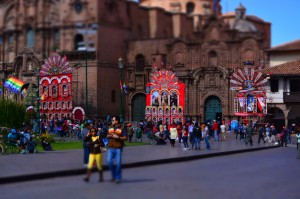
They share a complex of associations with public celebrations of both the secular and the religious sacred.

While Spanish developed in a world of Tridentine Catholicism and the baroque state which emphasized such public celebrations to both fight of Protestantism and nurture a public order where public ritual reached out and claimed practices even behind the walls of private homes to create both a secularly and religiously governable public, one that was measurable and knowable. These events reached into the cosmos to claim organization and order while creating fertility and society. They were very important events.
English, on the other hand has lived its life in the embrace of a very different reality. It lived uprisings against the Roman way. Ritual became ritualism and festus feast. This sister has spent its adult life in world created by Roundheads and Cromwell, as well as Quakers, Baptists and Methodists. Their world celebrates public sobriety and reason over ceremony, although emotions often break out in private.
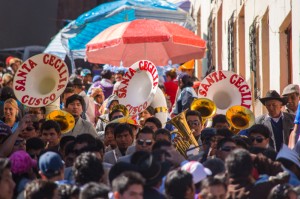
You can see this in the Oxford English Dictionary’s definition of feast. The primary meaning it gives for the word is a large meal, especially a ceremonial one. The festus no longer has to be public, but can be primary or a celebration of smaller groups such as families or religious groups.
The dictionary goes on to day a feast is “something delightful” and further on |a festival; a holiday; a solemn, or more commonly, a joyous, anniversary. At thee very end of the list we find a definition that moves towards the primary meaning in the Royal Spanish Academy’s definition of fiestas.
This serious and official record of the Spanish language writes that a feast is: “a day in which is celebrated some national solemnity, and in which are closed offices and other public establishments.”
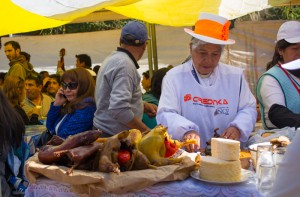
In other words, Spanish emphasizes the public and the national, as well as the claim to a priority over public space. Rather than a meal, although there may be such, the Iberian emphasizes the role of a festus as a representation and instantiation of the nation. It claims priority in people’s lives.
The second definition continues to strike a different course than the English. It is ” A Day in which the Church celebrates with major solemnity than others”. It further specifies this by saying: “A Solemnity with which is celebrated the memory of a saint.”
A festus, in other words, marks the Catholic Church as a public agency related to the state, whose celebrations are akin to those of the nation in claiming public time and space and marking the hierarchy of sacred in ordinary life.
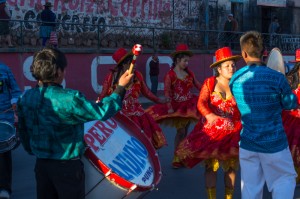
Though England has an official Church, the Anglican, the relationship ever since the massive growth of Methodism and other dissenting faiths, as well as the continuity of large numbers of Catholics, has not been as exclusive as a representation of the public in the UK. As sociologists such as David Martin have written, the tie between a religion and society was split asunder in the English world.
In the Spanish world, only in the last forty or so years has the Catholic Church been losing its strict tie to the public and the nation. Only recently has religious pluralism begun to develop and that has not yet made its way into the definition of the word fiesta.
Finally, the Spanish defines a fiesta as: “Fun or joy”. . . “a gathering of people to celebrate some happening or simply to have fun.”
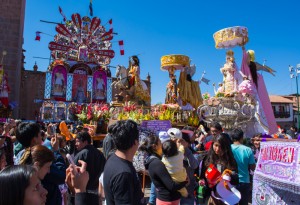
With this final stroke, the Spanish moved away from the English feast, despite its emphasis on private celebration, and into the domain of the English party.
Of course those years of separation were not years of isolation. The sisters, Spanish and English have conversed occasionally and their worlds have influenced each other. For example, Spanish has recently borrowed the English festival, although it coexists somewhat uncomfortably with fiesta and has yet to claim a stable place of its own.
Still, it is very difficult to translate the Spanish fiesta into English and vice a versa. It is also difficult for the speakers of one language to get what those of the other language mean when they talk of fiestas, feasts, or parties.

In Cuzco, it is even more complicated. I am told the world of teens and people in their twenties is one that emphasizes the parties, even in the religious and public fiestas. though officially solemn, they also enclose spaces of youth coming together to drink, dance, hang out, and spend time with each other. This space blends into that of discotheques and bars where people also party and where either the word fiesta, or better Cuzco’s “tono” or the verb “tonear” are appropriate.
In the solemn spaces of older people, into which the youths are sometimes drawn with solemnity, you have a hierarchy of celebrations and organizations stretching from the nation and Church down to the neighborhood, institution / organization, and family. This structure of events organizes and controls social life in Cuzco and other Spanish speaking worlds, although always somewhat differently since each place has its own history.




